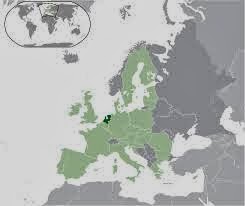The geography of the Netherlands is unusual in that much of its land has been reclaimed from the sea and is below sea level, protected by dikes. Another factor that has influenced its physical appearance is that the country is among the most densely populated on earth. It is ranked 15th overall on that scale, but is behind only three countries having a population over 10 million. Necessarily, the Netherlands is highly urbanise
The country can be split into two areas:
- the low and flat lands in the west and north. These lands, including the reclaimed poldersand river deltas, make up about half of its surface area and are less than 1 m (3.2 ft) above sea level, much of it actually below sea level. An extensive range of seawalls and coastal dunes protect the Netherlands from the sea, and levees and dikes along the rivers protect against river flooding.
- the higher lands with minor hills in the east and south. Even this portion is mostly flat; only in the extreme south of the country does the land rise to any significant extent, in the foothills of the Ardennes mountains. This is where Vaalserberg is located, the highest point on the European part of the Netherlands at 322.7 metres (1,059 ft) above sea level

